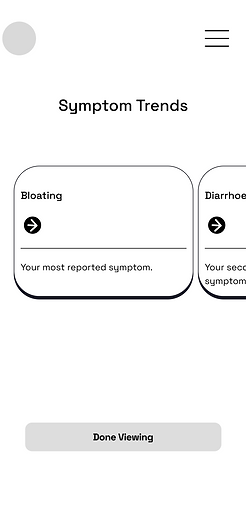Namrata Adsul
Product Design
I designed a mobile healthcare app to empower patients by enabling real-time symptom tracking and AI-powered insights while facilitating seamless communication with healthcare providers during long wait times for medical procedures. The app serves as a comprehensive platform for managing health-related anxiety, offering features such as symptom logging with intensity scales, AI-generated trend analysis, and the ability to share flagged patterns with doctors. It also includes mindfulness exercises and a chat function for direct communication with medical professionals. By providing patients with greater control, personalized insights, and proactive support, the app aims to significantly enhance the overall patient experience, promoting reassurance, better-informed care, and improved well-being.
Problem Space
Prolonged Wait Times
Patients face extended delays for essential procedures, such as joint replacements and cataract surgeries, due to limited healthcare resources and the backlog caused by pandemic disruptions.
Increased Anxiety and Uncertainty
The uncertainty surrounding surgery timelines leaves patients feeling anxious and stressed about their health, impacting their emotional well-being.
Decline in Quality of Life
Delayed access to necessary medical care reduces patients' mobility, independence, and overall quality of life, making everyday activities increasingly challenging.
User Persona
I developed this user persona through a structured process, starting with affinity mapping—conducting one-on-one user interviews to uncover key themes, patterns, and pain points. Using these insights, I created a detailed user persona. To further inform the design process, I mapped Sarah’s journey to discovering the app, allowing me to empathize with her experience and identify critical challenges and pain points.

Sarah maintains a busy schedule balancing her career and family responsibilities. She prioritizes her family's well-being, ensuring they have access to quality healthcare when needed. She tends to avoid confrontations and prefers clear communication in all aspects of her life. Sarah values efficiency and convenience in healthcare services due to her demanding schedule.
Age: 35
Gender: Female
Occupation: Working professional
Family: Two children
How Might We
support and provide assurance to patients while they wait for their medical procedure?
Mobile Application User Flow
This mobile app user flow demonstrates how Mrs. Johnson navigates the Symptom Check-in and Symptom Trends feature.
User Story: As a patient waiting for a diagnostic medical procedure, I want to keep track of and share how I am feeling in real-time so that I feel assured that my condition is not getting worse. feature.

With Sarah's endoscopy still three months away, her doctor has asked her to use the app to track her symptoms and monitor any changes. She opens the app and heads to the “Symptom Check-In” button to log her symptoms for the day.
The AI offers contextual insights, such as “Patients scheduled for an endoscopy often report these symptoms.”
.png)


On the Symptom Check-In screen, Sarah selects “Bloating” and rates it at 1 on the intensity scale, indicating mild discomfort. She then selects “Diarrhea” and rates it at 4, signaling a more severe issue. She notices an option to type in custom notes, but the intensity scale helps closely match her condition.
.png)

Once she’s done logging her symptoms, Sarah taps the “Trends” button to track her progress. She selects “Bloating” and sees a downward trend over the past few weeks. The app highlights this with an AI-generated insight, suggesting:
“Your bloating symptoms have gradually decreased over the last two weeks. This may indicate a positive response to your current treatment or dietary adjustments.”
Feeling encouraged, Sarah moves on to review her diarrhea trends.

While exploring the "Diarrhea" section, Sarah notices her symptoms have been consistently severe throughout May. The app automatically flags this trend and prompts:
“You’ve experienced high-intensity diarrhea for 15 consecutive days. Would you like to share this update with your doctor?”
The app detects symptom trends and generates visual reports, highlighting patterns and changes.
On the Classroom Insights selection screen, Mrs. Johnson is presented with various areas of concern and interest related to her child’s education. She carefully selects one or multiple areas that she is most curious about or worried about.
Product Roadmap
Using AI-Powered Chat with Healthcare Providers
Goal: Empower Sarah to easily communicate with her doctor and seek timely support.
Prompt enhancement
The AI refines Sarah’s message by structuring it clearly and highlighting key symptoms.
Smart summaries
The AI generates a concise symptom history for the doctor, reducing the need for back-and-forth communication.
AI-powered recommendations
While waiting, Sarah receives evidence-based suggestions for pain management, such as hydration tips or dietary adjustments.
01
From the main menu, Sarah selects the Chat with Provider feature. She types in a concern (e.g., “My pain has worsened over the last two weeks.”).
03
She sends the message, and the app automatically compiles a summary of her recent symptom logs to provide the doctor with a clear overview.
02
The AI suggests pre-filled message templates based on her logged symptoms, making it easier to communicate.
04
Sarah receives a personalized AI-generated response with general care tips while waiting for the doctor’s reply.
Proactive Notifications & Reminders
Goal: Keep Sarah engaged and consistent in using the app.
Intelligent reminders
The AI identifies when Sarah is most likely to forget to log symptoms and sends timely nudges.
Contextual alerts
AI flags any worsening trends and encourages Sarah to contact her healthcare provider.
01
The app sends personalized reminders (e.g., “Time to log your symptoms” or “Check in with your healthcare provider”) based on Sarah’s activity patterns.
02
She receives proactive notifications when the AI detects concerning symptom patterns (e.g., sudden spike in pain intensity).